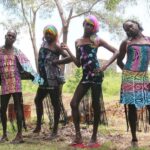Quote:
Since European contact Aboriginal people, such as myself, have been constructed as “straight”. This cultural default has contributed to the difficulty of proving so-called “real accounts” of sexual and gender diversity of Aboriginal people prior to European contact. (…) It is not inconceivable that homophobia and transphobia are practices introduced by the Christian missionaries. The social order of the missions, in an attempt to “civilise the natives”, limited Aboriginal expression.
Source:
Troy-Anthon Baylis (15.04.2014): The art of seeing Aboriginal Australia's queer potential. In: The Conversation.
Author Bio:
Troy-Anthony Baylis (born in 1976) is a Jawoyn Aboriginal from northern Australia. He is an artist, curator and writer.
Context:
 Troy-Anthon Baylis researches gender diversity and has found that there are indigenous names for non-binary genders on the Australian Tiwi Islands (The Hook Up 2018). Non-heterosexual concepts such as “two-spirit” in North America, were part of sexuality in many pre-colonial societies. These were viewed by the Christian Church and colonialists as immoral reprehensible and therefore forbidden. In the Catholic Church, homosexuality and non-procreative sex were condemned as early as the Third Lateran Council of 1179 (Boswell 1981, quoted from Federici, 2014: 47) as a sin against nature (Spencer 1995, quoted from Federici, 2014: 47).
Troy-Anthon Baylis researches gender diversity and has found that there are indigenous names for non-binary genders on the Australian Tiwi Islands (The Hook Up 2018). Non-heterosexual concepts such as “two-spirit” in North America, were part of sexuality in many pre-colonial societies. These were viewed by the Christian Church and colonialists as immoral reprehensible and therefore forbidden. In the Catholic Church, homosexuality and non-procreative sex were condemned as early as the Third Lateran Council of 1179 (Boswell 1981, quoted from Federici, 2014: 47) as a sin against nature (Spencer 1995, quoted from Federici, 2014: 47).Further Reading:
*The Hook Up (2018): What do we know about queer Indigenous history?
*Silvia Federici (2014): Caliban und die Hexe. Frauen, der Körper und die ursprüngliche Akkumulation. Wien: Mandelbaum.
*Pearson McKinney (2016): Before European Christians Forced Gender Roles, Native Americans Acknowledged 5 Genders.
**Arabmediasociety.com, 21.01.2009: Book Review Desiring Arabs.